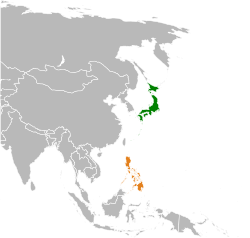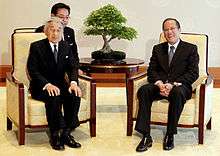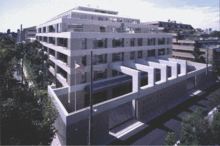Japan–Philippines relations
 |
|
Japan |
Philippines |
|---|---|
Japan–Philippines relations (Japanese: 日本とフィリピンの関係 Hepburn: Nihon to Firipin no kankei) and (Filipino: Ugnayang Pilipinas at Hapon), span a period from before the 16th century to the present.[1][2][3][4]
Early Japanese presence in the Philippines
Relations between Japan and the Philippines date back to at least the late Muromachi period of Japanese history, as Japanese merchants and traders had settled in Luzon at this time. Especially in the area of Dilao, a suburb of Manila, was a Nihonmachi of 3,000 Japanese around the year 1600. The term probably originated from the Tagalog term 'dilaw', meaning 'yellow', which describes their general physiognomy. The Japanese had established quite early an enclave at Dilao where they numbered between 300 and 400 in 1593. In 1603, during the Sangley rebellion, they numbered 1,500, and 3,000 in 1606.
In 1593, Spanish authorities in Manila authorized the dispatch of Franciscan missionaries to Japan. The Franciscan friar Luis Sotelo was involved in the support of the Dilao enclave between 1600 and 1608.
In the first half of the 17th century, intense official trade took place between the two countries, through the Red seal ships system. Thirty official "Red seal ship" passports were issued between Japan and the Philippines between 1604 and 1616.[5]
The Japanese led an abortive rebellion in Dilao against the Spanish Empire in 1606-1607, but their numbers rose again until the interdiction of Christianity by Tokugawa Ieyasu in 1614, when 300 Japanese Christian refugees under Takayama Ukon settled in the Philippines. On 8 November 1614, together with 300 Japanese Christians Takayama Ukon left his home country from Nagasaki. He arrived at Manila on 21 December and was greeted warmly by the Spanish Jesuits and the local Filipinos there. The Spanish Philippines offered its assistance in overthrowing the Japanese government by invasion to protect Japanese Catholics. Justo declined to participate, and died of illness just 40 days afterwards. These 17th-century immigrants are at the origin of some of today's 200,000-strong Japanese population in the Philippines.
More rebellions such as one known as the Tondo conspiracy had Japanese merchants and Christians involved, but the conspiracy was disbanded. Toyotomi Hideyoshi also threatened the Spanish to leave or face full scale Japanese invasion, however this was near his decline and death, and it wasn't long before the Tokugawa rose in power right after.
However, by the mid-17th century, Japan had established an isolationist policy, and contacts between the two nations were severed until after the opening of Japan in 1854. In the 16th and 17th centuries, thousands of Japanese traders also migrated to the Philippines and assimilated into the local population.
Philippines and the Empire of Japan
During the 1896 uprising against Spanish colonial rule the 1898 Spanish–American War, Filipino freedom-fighters (especially the Katipunan) sought assistance from the Japanese government. The Katipunan sent a delegate to the Emperor of Japan to solicit funds and military arms in May 1896.[6][7] Although the Meiji government of Japan was unwilling and unable to provide any official support, Japanese supporters of Philippine independence in the Pan-Asian movement raised funds and sent weapons on the privately charted Nunobiki Maru, which sank before reaching its destination. However, under the terms of the Taft–Katsura Agreement of 1905, the Japanese government officially acquiesced to American colonial rule over the Philippines.
During the American period, Japanese economic ties to the Philippines expanded tremendously and by 1929 Japan was the largest trading partner to the Philippines after the United States. Economic investment was accompanied by large-scale immigration of Japanese to the Philippines, mainly merchants, gardeners and prostitutes ('karayuki-san'). Japanese immigrants Davao in Mindanao, had over 20,000 ethnic Japanese residents. By 1935, it was estimated that Japanese immigrants dominated 35% of Philippine retail trade. Investments included extensive agricultural holdings and natural resource development. By 1940, some 40% of Philippine exports to Japan were iron, copper, manganese and chrome.
During World War II, immediately after the attack on Pearl Harbor, Japanese forces invaded and quickly overcame resistance by the United States and Philippine Commonwealth military. Strategically, Japan needed the Philippines to prevent its use by Allied forces as a forward base of operations against the Japanese home islands, and against its plans for the further conquest of Southeast Asia. In 1943, a puppet government, the Second Philippine Republic, was established, but gained little popular support, primarily due to the Imperial Japanese Army's brutal conduct towards the Philippine civilian population. During the course of the Japanese occupation, and subsequent battles during the American and Filipino re-invasion, an estimated one million Filipinos died, giving rise to lingering anti-Japanese sentiment.
Post-war relations



The Philippines was granted independence by the United States in 1946, and was a signatory to the 1951 San Francisco Peace Treaty with Japan. Diplomatic relations were re-established in 1956, when a war reparations agreement was concluded. By the end of the 1950s, Japanese companies and individual investors had begun to return to the Philippines.
Japan and the Philippines signed a Treaty of Amity, Commerce and Navigation in 1960, but the treaty did not go into effect until 1973, when then-President Ferdinand Marcos abolished the Philippine legislature under martial law and ratified the treaty ten days prior to the visit of Japanese Prime Minister Kakuei Tanaka. By 1975, Japan had displaced the United States as the main source of investment in the country.
Hirohito met with then President Ferdinand Marcos in a state visit by the latter to Japan in 1966.[8]
Japan remained a major source of development funds, trade, investment, and tourism in the 1980s, and there have been few foreign policy disputes between the two nations.
When Philippine President Corazon Aquino's administration was installed as a result of the People Power Revolution, Japan was one of the first countries to express support for the new Philippine government.[9]
Philippine President Corazon Aquino visited Japan in November 1986 and met with Emperor Hirohito, who offered his apologies for the wrongs committed by Japan during World War II. New foreign aid agreements also were concluded during this visit. Aquino returned to Japan in 1989 for Hirohito's funeral and in 1990 for the enthronement of Emperor Akihito.
Regarding the voting of the Philippine Senate to extend a treaty allowing the stay of U.S. bases in the Philippines, Japan was in favor for the extension of the defense treaty. In fact, some of its officials including Ambassador Toshio Goto, Foreign Minister Taro Nakayama and Prime Minister Toshiki Kaifu expressed public disagreement on a negative vote on the extension. However the Philippine Senate rejected the extension of the defense treaty despite extensive lobbying for its extension by the first Aquino administration, even calling for a referendum regarding the matter.[10][11]
Upon the withdrawing of the vast majority of American troops in the Philippines, relations between the United States and the Philippines remained strong as assumed by US President Bill Clinton to Philippine President Fidel V. Ramos during the latter's visit to Washington on 21 November 1993. Likewise the Philippines-Japan relations were strengthened with Japan filling the gap the United States left. Even before Ramos became President he held talks with the Japan Ministry of Defense to improve defense relations as Defense Secretary under Corazon Aquino's administration. [12]
During a meeting with President Ramos in 1993, Japanese Prime Minister Kiichi Miyazawa reiterated his apology for his country's war crimes committed against the Philippines and its people during the World War II and would consider the best way to address the issue. The Ramos administration also supported Japan's bid to become a permanent member of the United Nations Security Council, together with Germany.[13]
Japan also became the top donor of aid to the Philippines, followed by the United States and Germany. Japan also contributed the largest amount of international aid to the Philippines after the later suffered from the 1990 Luzon earthquake and 1991 Mount Pinatubo eruption.[14]
Strategic relationship between the two countries has been strong recently. Japan supports the resolution of the Islamic insurgency in the Philippines.[15] In 2013, Japan announced it would donate ten ships valued at US$11 million to the Philippine Coast Guard. Japan and the Philippines share a "mutual concern" on China's increasing assertiveness in its territorial claims.[16][17]
In November 2015, the Philippine government and the Japan International Cooperation Agency (JICA) signed a $2-billion loan agreement for the JICA to fund part of the construction of a railway system between the Tutuban railway station in Manila to Malolos, Bulacan in the Philippines, which is targeted to become the country's largest railway system. According to the Philippine Department of Finance, the agreement was the JICA's "largest assistance ever extended to any country for a single project."[18][19]
In February 29, 2016, Japan Signed a pact to supply defense equipment to Philippines. The agreement provides a framework for the supply of defense equipment and technology and will allow the two countries to carry out joint research and development projects.[20][21] In April 3, 2016, Japanese training submarine JS Oyashio, along with two destroyers JS Ariake and JS Setogiri docked at the Alava Pier in Subic Bay for a three-day goodwill visit.[22]
See also
- Japanese settlement in the Philippines
- Filipinos in Japan
- Dom Justo Takayama
- Domingo Siazon
- Marcos scandals
- Taft–Katsura Agreement
- Diwata (satellite)
References
- ↑ Hisona, Harold (14 July 2010). "The Cultural Influences of India, China, Arabia, and Japan". Philippine Almanac. Retrieved 10 June 2013.
- ↑ Kekai, Paul (5 September 2006). "Quests of the Dragon and Bird Clan: Luzon Jars (Glossary)". Sambali.blogspot.com. Retrieved 10 June 2013.
- ↑ "Ancient Japanese pottery in Boljoon town | Inquirer News". Newsinfo.inquirer.net. 30 May 2011. Retrieved 10 June 2013.
- ↑ "Philippines History, Culture, Civilization and Technology, Filipino". Asiapacificuniverse.com. Retrieved 10 June 2013.
- ↑
- Boxer, C.R., The Christian Century in Japan, 2001 Carcanet, Manchester, ISBN 1-85754-035-2 p.264
- ↑ "History Of Katipunan - Home On The Net". Katipunan.weebly.com. Retrieved 10 June 2013.
- ↑ http://joserizal.nhcp.gov.ph/Biography/man_and_martyr/valenzuela_pio.htm
- ↑ "Marcos arrives for Japan visit". 30 September 1966. Retrieved 26 August 2016.
- ↑ Ikehata, Setsuho; Yu-Jose, Lydia, eds. (2003). Philippines-Japan Relations. Ateneo De Manila University Press. p. 580. ISBN 971-550-436-1.
- ↑ DAVID E. SANGERPublished: 28 December 1991 (28 December 1991). "Philippines Orders U.S. to Leave Strategic Navy Base at Subic Bay - New York Times". Nytimes.com. Retrieved 10 June 2013.
- ↑ Ikehata, Setsuho; Yu-Jose, Lydia, eds. (2003). Philippines-Japan Relations. Ateneo De Manila University Press. p. 584. ISBN 971-550-436-1.
- ↑ Ikehata, Setsuho; Yu-Jose, Lydia, eds. (2003). Philippines-Japan Relations. Ateneo De Manila University Press. pp. 579, 585. ISBN 971-550-436-1.
- ↑ Ikehata, Setsuho; Yu-Jose, Lydia, eds. (2003). Philippines-Japan Relations. Ateneo De Manila University Press. pp. 588, 593. ISBN 971-550-436-1.
- ↑ Ikehata, Setsuho; Yu-Jose, Lydia, eds. (2003). Philippines-Japan Relations. Ateneo De Manila University Press. pp. 580–581. ISBN 971-550-436-1.
- ↑ "Visit to Japan of the Moro Islamic Liberation Front (MILF) Peace Negotiating Panel". MOFA. Retrieved 10 June 2013.
- ↑ Julius Cesar I Trajano (14 March 2013). "Japan and Philippines align strategic interests". Asian Times. Retrieved 18 March 2013.
- ↑ "Japan-Philippine Relations: New Dynamics In Strategic Partnership - Analysis Eurasia Review". Eurasiareview.com. 5 March 2013. Retrieved 10 June 2013.
- ↑ de Vera, Ben (28 November 2015). "PH, Japan agency sign $2-B railway loan". Philippine Daily Inquirer. Retrieved 20 December 2015.
- ↑ Magtulis, Prinz (27 November 2015). "Japan's $2-B loan to fund Philippines's largest railway system". The Philippine Star. Retrieved 20 December 2015.
- ↑ "International News: Latest Headlines, Video and Photographs from Around the World -- People, Places, Crisis, Conflict, Culture, Change, Analysis and Trends". ABC News.
- ↑ "Japan signs pact to supply defense equipment to Philippines".
- ↑ "Japanese submarine, destroyers dock in Subic".
![]() This article incorporates public domain material from the Library of Congress Country Studies website http://lcweb2.loc.gov/frd/cs/.
This article incorporates public domain material from the Library of Congress Country Studies website http://lcweb2.loc.gov/frd/cs/.

